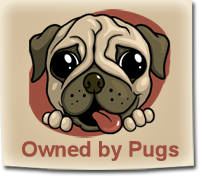Caring for your pug’s pearly whites
By OwnedByPugs.com
January 31st, 2008
Do you know what the most common disease is for dogs and cats? Surprisingly, it is periodontal disease. Because of the number of cats and dogs that suffer from periodontal disease, February has been named National Pet Dental Month.
What is Periodontal Disease
Periodontal disease, also known as Gum disease, is an infection that is caused by bacteria found in dental plaque. After time, plaque builds up on teeth around the gum line. If the plaque is not removed, the bacteria in the plaque can cause an infection in the gums, teeth and even the surrounding bone. The Veterinary Oral Health Clinic also notes, "Studies have shown that dogs with severe periodontal disease have more severe microscopic damage in their kidneys, heart muscle and liver than do dogs with less severe periodontal disease."
How do I know if my pug has periodontal disease?
The best thing to do is take a peak inside your pug's mouth. You will not be able to immediately tell if your pug has periodontal disease, your veterinarian will need to make that determination, but you will get a good idea of the condition of your pug's teeth. Look for plaque buildup and inspect the gum line. Is it red or irritated? Does your pug have any loose teeth?
Other signs of periodontal disease include:
- Bad breath
- Irritated and bleeding gums
- Change in eating or play habits. If their mouth is sore, your pug may stop eating crunchy treats or playing with their toys.
- Loose teeth
What to do
If your pug has severe tarter build up, irritated gums and possible loose teeth, you will want to see a veterinarian to get a full diagnosis and find out your best course of action.
The main thing to focus on is prevention. The best way to prevent gum disease is to brush your pug's teeth, which if it was easy we would all be doing it already. But it is important enough to make an effort. Pugs already have one strike against them in the dental department from the start. All dogs have 42 teeth. From Great Danes to Chihuahuas, all dogs are bestowed 42 pearly whites. However, getting 42 teeth into a pug's mouth isn't an easy task. With no snout, there are serious crowding issues inside your little pug's mouth. Crowding makes it much easier for bacteria to form and makes pugs, along with other small dogs, more susceptible to dental issues.
Brushing
I know brushing your pug's teeth is no easy task. They are not really too keen on us sticking a toothbrush in their mouth and there really isn't much room in there to begin with. The best thing to do is to get them used to having their teeth brushed as a puppy, but don't give up hope, older pugs can learn to like to have their teeth brushed too.
First, always make sure that you use toothpaste made especially for dogs. You will find that they make toothpaste in various flavor like Poultry and Beef. Flavors that your dog will enjoy and we would never dream of using in our mouth. Most pugs will actually like the taste of the toothpaste so pick a flavor you think your pug will enjoy.
I always start out by putting a little dab of toothpaste on the toothbrush and let my pug lick it off. This makes it like a game to them and helps them learn to like the toothbrush before I go sticking it in their mouth. After they finish licking up the toothpaste, I refill the toothbrush and then go to brushing. You will want to gently lift their jowls and gently brush.
If your pugs are anything like mine, they will try to bite the toothbrush while you are brushing. For the most part, I let them. As long as the brush is moving around touching the surface of their teeth, you are doing your job. Unless you have trained your pug to get their teeth brushed, you are not going to get the opportunity to brush each individual tooth. My mentality is to get the most done in a short period of time. I don't want to spend more than a few minutes brushing their teeth as I don't want this to be an experience they grow to dread. The fact that you are brushing your pug's teeth and you are doing it regularly will make a big difference.
Dental Products
If you have been to the pet store recently you will know that there are plenty of products claiming to be good for your pug's teeth. From toys and bones to water additives, it can be overwhelming trying to figure out which products actually work and are safe for your pug. The best thing to do is to read the packaging and check for the Veterinary Oral Health Council seal of approval.
The Veterinary Oral Health Council was founded to help guide consumers and show us what products really to do live up to their claims.
Awareness
One of the best things is overall awareness of your pug's dental health. Regular teeth brushing along with regular dental checkups at the vet go along way in protecting your pug's pearly whites and making sure they live a happy and fulfilling life.
